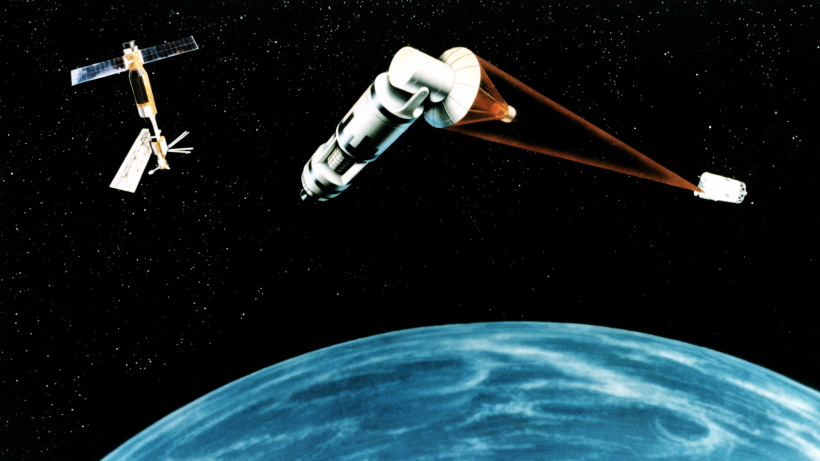Trump Requests Space-based Missile Defense Plan

An artist’s concept of a laser-equipped satellite envisioned by President Ronald Reagan’s Strategic Defense Initiative in the 1980’s.
Air Force
President Donald Trump is pushing for the creation of a missile defense shield capable of protecting the U.S. against “any foreign aerial attack,” including from ballistic and hypersonic missiles. An executive order
The order represents a seismic change in U.S. missile defense policy, which previously focused on defending against a relatively small attack from countries such as North Korea or Iran rather than shielding against any scale of attack from larger countries such as Russia or China.
Trump’s order references the Reagan administration’s effort to build space-based missile defense systems, saying it “resulted in many technological advances” but “was canceled before its goal could be realized.” A similar concept continued under George H.W. Bush
Critics of Reagan’s program dubbed it “Star Wars,” believing it to be unachievable. Multiple studies since Reagan’s 1983 announcement of the program, called the Strategic Defense Initiative, concluded that space-based missile defense interceptors and lasers are infeasible due to their size, cost, and susceptibility to countermeasures. These studies include an American Physical Society report
The leading concept for space-based missile defense would use interceptors disguised as ordinary satellites. These interceptors would monitor missile launch sites and, in the event of a launch, use rocket engines to leave orbit and collide with the missile. The appeal of space-based missile defense over ground-based is the system’s proximity to launched missiles, allowing them to reach the missile during the “boost phase” shortly after launch, which prevents the use of decoy warheads that confuse missile defense systems.
However, various analysts have argued that such an interceptor system would be prohibitively costly due to the redundancy in orbiting interceptors needed to make sure enough of them are in range of their targets at any given time.
The Union of Concerned Scientists estimated
Trump’s order also refers to “non-kinetic capabilities,” which could include concepts like the space-based X-ray laser ideated at Lawrence Livermore National Lab during the Reagan administration.
Using lasers would require hundreds of billion-dollar satellites, a prohibitively high cost, said Frank von Hippel, a senior research physicist at Princeton University and co-founder of the Physicists Coalition for Nuclear Threat Reduction, in an interview.
Meanwhile, some analysts have said that reduced launch costs in recent years may make space-based missile defense more economically feasible. In 2018, then-Under Secretary of Defense for Research and Engineering Michael Griffin said
At an event on nuclear missile deterrence in January, former Defense Department official Robert Soofer pointed to Griffin’s comments as evidence that space-based interceptors are not a distant prospect. “That was four years ago. Given the exploits of SpaceX and their ability to put up hundreds, if not thousands, of relatively inexpensive small satellites. I wonder if even $20 billion is at the high end, but we just don’t know,” Soofer said. He advocated for the U.S. to build out its missile defense against more types of attacks, though he did not call for a system as comprehensive as the one Trump has proposed.
In an interview, Theodore Postol, a physicist and professor emeritus of science, technology, and international security at MIT, acknowledged that SpaceX has seen significant innovations in rocketry that make it easier to launch objects into low-Earth orbit. However, these engines would lack the thrust needed for the interceptor to leave its orbit and destroy an incoming missile, considering the interceptor’s propellant and weight.
“Unless somebody can come up with a propellant that is completely different from anything anybody knows about, the interceptors are going to be limited,” Postol said. “I can describe all kinds of innovations in rocketry, which is significant… but none of them change the basic equation.”
Even if achieved, the current ideas for space-based defense systems would be easy to counter, some experts maintain. David Wright, a research affiliate at the MIT Laboratory for Nuclear Security and Policy, noted that other countries could easily track interceptors from the ground and anticipate their positions to launch attacks when interceptors are out of range or to attack the interceptors themselves. Space-based lasers could easily be destroyed by lofting sand into their orbit in front of them, von Hippel suggested.
Some scientists argue that building all-powerful missile defense systems only encourages nuclear buildup in adversarial countries. “Russia and China already appear to be building new types of weapons with the purpose of defeating or avoiding missile defenses,” said Laura Grego, research director of the Global Security Program at the Union of Concerned Scientists, in a statement
“It’s basically everything and the kitchen sink. It’s sort of going back to the Reagan idea, ‘we want to be able to protect ourselves from any kind of attack.’ And that’s a very appealing image,” Wright said regarding Trump’s order. “It just feels to me like we’ve seen this process play out any number of times, and people have to relearn these basic lessons of how difficult it is when you’re trying to not solve a physics problem, but you’re trying to work against an adversary.”


